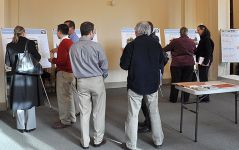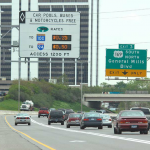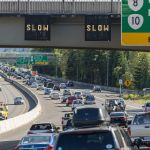Your input is essential
In the next few minutes, you can learn more about value pricing, how it could help address increasing congestion, and what to expect as the analysis moves forward. You play an important role in this process! We want to know what you think.
The Oregon Transportation Commission (OTC) is the pricing authority in Oregon. The OTC, as directed by the state legislature, will use this analysis to develop a proposal for value pricing for review by the Federal Highway Administration in late 2018.
After 2018, additional public input and technical analysis will be needed.
To learn more, select a station below or click the buttons at the top of the page.
Stations
By the numbers



Our region will continue to grow. Even as we make investments to make roads, transit, and active transportation better, state and regional planners predict congestion will continue to worsen.
The Portland Area Value Pricing Feasibility Analysis will help us determine whether value pricing could be part of a larger strategy to help manage congestion in the region.
Tell us about your travel experiences
The project team will use best available data to model projected congestion growth and how value pricing and other strategies can help. To help confirm existing traffic information, we want to hear from you: Where do you experience the greatest challenges traveling in the Portland metro area? Share your thoughts through our interactive map below.
(The interactive map closed Feb. 5, 2018.)
Value pricing is one potential solution
Value pricing, also known as congestion pricing or variable rate tolling, is a proven tool resulting in faster, more reliable and predictable trips.
How does value pricing work?
Value pricing uses fees or tolls to manage congestion. During more congested times of the day a higher fee is charged, encouraging some drivers to consider other travel options such as alternate routes, carpools, transit or travel at less congested times. This improves mobility for all drivers who pay the fee, and potentially for the entire system. Fees are collected electronically so drivers do not have to stop at toll booths.
There are over 40 active value pricing projects in the US. In Seattle, value pricing is used on the SR 520 floating bridge and the I-405 Express toll lanes.
For more information on value pricing as a tool to manage congestion see Summary of Value Pricing Concepts.
Objectives and performance measures have been developed to consider a range of factors:
- Traffic operations improvements, including reliability and reduction of congestion
- Diversion of traffic, including impacts to other roads and transit
- Transit service and active transportation, including where and how transit, biking and walking can serve as an alternative to travel on priced roads
- Equity impacts and whether the option will disproportionately impact disadvantaged communities, and how those impacts can be reduced
- Impacts on the community, economy, and environment within the region and beyond
- Public input and support for various options to address congestion
- Consistency with state and regional law and policy
- Feasibility under federal law and whether options will require a federal program waiver
- Project construction schedules and whether an option might change when other projects on the corridors are constructed
- Revenue and cost and whether options would cover costs and possibly help pay for other projects to improve congestion.
What types of value pricing?
We’re looking at initial "building block" concepts that can be combined in different ways to determine a solution that makes the most sense for our region.
Priced roadways
![]()
Priced roadways: This approach would price all lanes of the freeway on I-5 and I-205 (or segments of these freeways) with a variable fee that could fluctuate to help alleviate congestion.
Potential benefits:
- Reduces congestion for all travelers on the roadway
- Highest potential improvement in travel time reliability and efficiency for all drivers and transit on I-5 and I-205
- Higher potential to move people during peak periods
- Minimizes construction requirements
Priced lanes
![]()
Priced lanes (existing and new): Priced lanes on I-5 and I-205 (or segments of these freeways) would give drivers a choice to use the unpriced lanes or pay to use priced lanes and save time. Two different approaches to the “priced lane” concept are being considered. 1) an existing lane could be converted to a priced lane, or 2) a new lane could be added and priced.
Potential benefits:
- Highest potential improvement in travel time reliability and efficiency for drivers and transit using the priced lane
- Higher potential to move people during peak periods
- Provides a "free" option
How will we determine the type of congestion pricing to use?
The initial step in the evaluation of options is to learn about the different types of pricing (the building blocks) to understand how well they would work – or not – for this area. For the "testing" phase of the analysis, we developed a set of preliminary concepts. Watch this video for more detailed information.
These concepts are not proposals – the analysis and public input will inform the development of more refined concepts for additional analysis. Additional public input will be collected on the refined concepts in March.
Learn more
Analysis schedule
A region-wide public conversation about value pricing will continue throughout 2018. The Oregon Transportation Commission will submit a final report and proposal to the federal government by the end of 2018 for review.
Join an upcoming community conversation and talk with project staff
Participants in community conversations will learn more about how value pricing could help address increasing congestion and what to expect as the Value Pricing Feasibility Analysis moves forward. Staff will be on hand for one-on-one conversations and to take input at these informal, drop-in style events.
Three identical, drop-in sessions are offered:
Tuesday, Jan. 23
4:30 - 7:30 PM
Clackamas Town Center - Community room
12000 SE 82nd Ave, Happy Valley, OR 97086
Saturday, Jan. 27
10:00 AM - 1:00 PM
Lloyd Center - Level 1, Across from Macy's and near the ice rink
2201 Lloyd Center, Portland, OR 97232
Tuesday, Jan. 30
4:30 - 7:30 PM
Vancouver Community Library - Columbia Room
901 C St, Vancouver, WA 98660
Policy Advisory Committee
To help make sure that our unique values are represented in the final proposal, the Oregon Transportation Commission established a Value Pricing Policy Advisory Committee to guide ODOT through the value pricing feasibility analysis.
Representatives of local governments in Oregon and Washington, members of the business community, highway users, environmental justice advocates, public transportation advocates, and environmental advocates meet as a committee to advise the Oregon Transportation Commission by:
- Evaluating options to implement value pricing to reduce congestion on I-5 and I-205 in the Portland metro area
- Considering public feedback on various concepts
- Considering effects and potential mitigation strategies for evaluated options
- Providing input and recommendations on value pricing to inform the Commission’s proposal to the federal government
Visit the Policy Advisory Committee page for more information on upcoming meetings. All committee meetings are open to the public and can be watched via ODOT's live stream.
Federal approval
Federal law determines where tolling can and cannot occur on interstate highways. Depending on the findings of this analysis, ODOT may seek to implement congestion pricing under the federal Value Pricing Pilot Program, which can help to make tolling more flexible.
Stay informed and make your voice heard
Continued public review and input on value pricing is essential to help us fully evaluate value pricing and determine how best to implement it.
- Learn more about the project by visiting the website
- Send questions or comments to the project team
- Learn more about the Policy Advisory Committee and send members a comment



































